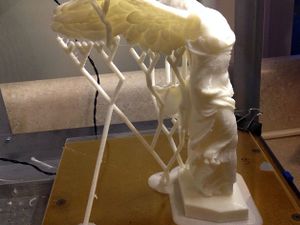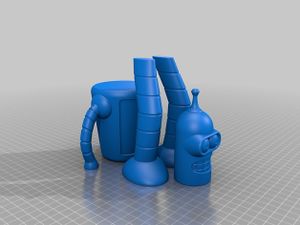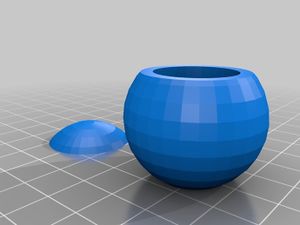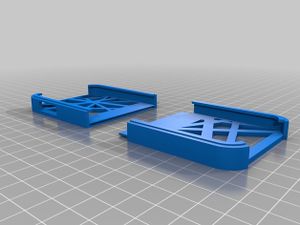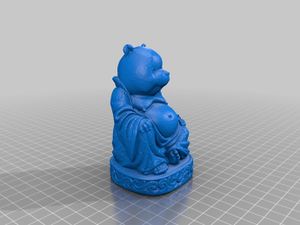User:Drewgolterman/Blogs
Contents
Blog 1: Thingiverse
A. Something amazing/beautifulFor an object that is amazing/beautiful, I chose to share this print of the Winged Victory of Samothrace. The statue itself is very beautiful, and I thought that it was amazing how it could be replicated so precisely. The Thingiverse user who created this, downeym, described how he used the following link (Link) to print the statue with minimal support material. And the following is a link to the Thingiverse article itself (Link).
For something that is funny and strange, I decided to share this figurine of Bender, from the TV show Futurama, which I found on Thingiverse. I have been a fan of the TV show for a while and I find Bender's character to be hilarious. Here is a link to the article for this print (Link).
When I was searching for something that was useless, I decided to type in "useless" to see what I would find, and I indeed found something extremely useless. This picture to the left is a one-sided die. And it is meant so that you can load it with a weight. For what purpose? I do not know. The link to this Thingiverse page is here.
I thought that this print of an Ipod 5 case would be extremely useful for me because I have been looking for a case that fits my own, but most of the Ipod cases sold are for previous generations. I thought that I could print this one for myself once I learn to download stl's and use the printers more effectively. The link to the Thingiverse article for this is here.
This surprised me because I could not imagine why someone would think to make a play on words of "Buddha" and "Winnie the Pooh." But apparently somebody did, and they then decided to create "Winnie the Poodha." This is one of the stupidest ones that I found on Thingiverse but it also made me laugh, which is why I included it for the last picture to share. Here's the link for this one.
Here's the link for this one. http: //www.thingiverse.com/thing:115029
Blog 2: Open Source Ecology Project Discussion
A: I think that the open source ecology project has an enormous potential. As Marcin stated in the video that was provided, people often become trapped in the “consumer” mentality of only looking at options that are presented to them rather than seeking their own solutions. By practicing an open source system of information with hardware, people can start being more productive by learning how to find their own solutions rather than being forced into seeking a select few “consumer” options, which may be against their interest in cost and feasibility. Also, the open source community has a large potential for developing communities that need cheap, feasible options for growing their economy.
However, after reviewing some of the project directions that are available, such as the CEB press (http://opensourceecology.org/wiki/CEB_Press) and the LifeTrac (http://opensourceecology.org/wiki/LifeTrac) I had some doubts about the feasibility of these projects for unskilled people. Although the designs that OSE offers are very simplified, they still might be overwhelming for someone who has never had any experience in mechanical construction. Given enough time to research the design, find the appropriate parts and reach out to experienced individuals, I think that these projects could be completed, but I have had doubts about their “one day goal.” The “one day goal” is their goal to create new designs that have the ability to be assembled in only a day. When they run the test of time that it takes to assemble these machines, I think they are overlooking how much more effort it may be for someone who is inexperienced with machinery and the possible bias that they have in being the designers of these machines. Since they are the most familiar with their own design, they are bound to assemble it quicker than anybody else can. The program’s most recent efforts, as shown in this video (http://vimeo.com/81154935), have included creating “work shops” for people to attend in order to learn how to build these essential machines. If Open Source Ecology wants to truly make an impact, I think that these workshops are the key way to teach other people how to assemble the open source machines. By having access to experienced machinists and builders, those who attend these workshops will not only be able walk away with their own machines, but they will also be able to learn essential skills from the leaders of these workshops. I think that in order to be successful in their mission, the open source community would not only have to provide access to the designs for these machines, but they would also have to provide access to people who are experienced in working with the machine components.
B: The New Yorker article, which can be found here, seems to focus on painting a quirky and eccentric picture of Marcin rather than actually weighing the pros and cons of his work. And as far as I can read from the article, the writer put very little effort into exploring the potential benefits of open source communities, such as the sharing of knowledge and ecological progress in developing countries, and focused more on Marcin’s unique background, views and projects. The writer also tends to assert the more pessimistic qualities of OSE’s efforts rather than inquiring about their potential. For example, she states that Marcin has faced “a dearth of skilled acolytes: the people who show up at his farm typically display more enthusiasm for his ideas than expertise with a lathe or a band saw.” But rather than mention that Marcin is attempting to combat this problem with his “workshops,” which are meant to educate these unskilled people, she simply mentions this fact as a way of seemingly discrediting Marcin’s efforts. Although the author has a point to address critical issues, such as how to train unskilled people, she scarcely addresses the potential benefits of OSE’s projects.
Marcin’s response to this article can be found here. After reading the response, I think that it was an appropriate way to address several “misconceptions” that were presented in the New Yorker article. Marcin states that the goals of his project are idealistic, but nevertheless they are necessary to address common worldly issues such as material scarcity. He also addresses the writer’s tendency to give him the air of being a “luddite” or leader of a “commune,” which would both carry negative connotation in the eyes of readers because they are associated with outlandish characteristics. However, Marcin continues to uphold the “one day goal” again, which I still happen to think is unrealistic for anyone other than the designers themselves. I continue to think that he underestimates the amount of work that will be involved for unskilled people. In my opinion, I think that he should have addressed this concern more directly in his response to show that he is considering the implications of teaching people the necessary skills to build OSE’s designs.
C: I have never had any professor that would be involved with agriculture, however I think that my previous ME 480 professor, Yash Tambawala, may have an interest in the mechanical design part of the project. The class that he taught was “Mechanical Analysis of Linkages.” I think that he would have had an interest in the researching these open source designs because they are directly related to some of the examples that we have studied in class. Also, if we had the opportunity to build one of them, it would be a great way of exercising the skills that we learned in class. However, I think that he may be leaving the Penn State MNE department this semester.
Aside from Professor Tambawala, I would also consider some of the Mechanical Engineering professors that are involved with linkages and mechanical design, because these topics relate directly to the open source designs that Marcin has shared. Also, the fact that they can be assembled with readily available materials (for the MNE Department) such as steel tubing, cables and hydraulics demonstrates that they would be a great project for a college-level environment.
Blog 3: Kansas teen uses 3-D printer to make hand for boy
When Mason Wilde was looking to create a hand for Matthew, he slightly adjusted the design that was originally created by Ivan Owen and Richard Van. These two men met online and were working to create mechanical fingers for Van, after he had lost part of his hand in an accident with a table saw. During their progress, a woman from South Africa contacted them and asked them to attempt to create a mechanical hand for her son, who was born without fingers on his right hand. They first created this hand out of metal parts that they had machined. After testing the design, they then chose to make a more refined 3D-printed version, after being donated a 3D-printer by Makerbot. After creating a more sound design, they uploaded the design with instructions to Thingiverse. The first 3D-printed version was uploaded in January of 2013.
If someone wished to create their own prosthetic hand, they could start by modifying the design that was uploaded here.
Here are some related news articles that discuss the "Robohand."
-American Society of Mechanical Engineers
Blog 4: Blog 2 Reflection
When reviewing the blogs of my classmates, I found that many of them had the same concerns that I had about the feasibility of unskilled people creating OSE's designs. Many of the articles reiterated that a lot of the designs will still require additional training for those who attempt to complete them. However, many of them were also able to see the potential benefits of having an open source system of designs, and they still generally liked the idea despite its unrealistic goals.
An interesting point that I would not have thought of on my own was brought up by Yuchao Yuan, who mentioned the issue of safety. If these designs are produced and not subject to certain standards, they may pose a potential threat to those who are assembling them, especially if they are unskilled people using power machinery. The project itself is already under enough criticism for its idealistic goals. If a fatal accident was to happen because of one of OSE's designs, that could cause a lot of negative publicity.
Also, I thought that Tom Vassa brought up a reasonable point in his blog response that I did not think of. He mentioned that the OSE project may not have as big of an audience as most of its supporters may think it will have. The reason that it will not have as big of an "audience" is that many of the unindustrialized areas that could potentially use the knowledge that OSE offers also may not have access to the proper tools that they will need to complete these projects. It seems to me that if someone truly wanted to help a developing area, they would have to send expertise as well as the design information from OSE. Someone who knows what kind of tools they need, how to get them and how to assemble the projects would need to help people in such areas.
Another thing that I never would have thought about, but read in Zachary Cameron's Blog response, is the help that OSE would offer people who are suffering in a Fallout situation. A potential apocalypse in the near future did not cross my mind at all. Even though it is highly unlikely, I thought that Zachary's assertion about population growth was thought provoking.
I also liked how Eva Abeniacar mentioned in her blog response that the New Yorker should be more "open" with their articles.
And lastly, I enjoyed reading about Nate Myer's opinion, because I liked hearing the view of someone who is familiar with the financial hassle that farmers must deal with when it comes to buying new equipment. I can understand why people sometimes criticize OSE's goals for being to idealistic when they claim to be a "Civilization Starter Kit," however I do not think that this should deter people from seeing the potential that it could have for those who are skilled with the proper tools and who can benefit from cost-effective, DYI equipment.
Blog 5
1. When reviewing the timeline, I would say that the single most important event was Charles Hull's role in technically creating the first "3D-Printer," which he referred to in terms of "Stereolithography." Although this was only the early development of 3D-Printers, and credit can also be given to those who made the technology more widely known in later years, Hull's contribution is vital to 3D-Printing's growth. Another significant event was in 1996, when the first major release of 3D printers from Z Corp, Stratasys, and 3D Systems was made to the public, thus spreading knowledge about 3D-Printing technology.
However, in terms of important events for the general public, I think that one of the most important events was the creation of open-source systems for people to learn, such as the RepRap blog (2005) and Thingiverse (2008). If the idea of having an "open source" community is to grow, it definitely needs resources such as RepRap and Thingiverse to help others develop their own skills.
And lastly, I think that another important event was when a lower jaw bone was printed for an 83-year-old patient in 2012. I think that this was significant because it not only demonstrated the bio-medical uses of 3D-Printing, but it also received a good deal of media attention, thus spreading knowledge about the technology even further.
2. On April 9th, 2012 an article was published by Time Tech. It was titled "The Delicious Future: 3D Chocolate Printer Finally Available for Purchase." I do not think that this a good example of an "important" event. I enjoy reading about the different things that people have found to print, but when it comes to printing food, I do not think that it is worth the time and investment. I understand that it might be note-worthy because every little bit of media coverage that the general public sees spreads the knowledge of 3D-Printing technology a little more; however, I think that it is hard to take something like 3D-printing chocolate seriously. And I also think that it only becomes a topic of jokes when other people discuss 3D-printing. Also, I find it funny how the title uses the word "Finally," as if people have been waiting for years for someone to make chocolate in unnecessarily complex geometries.
3.
